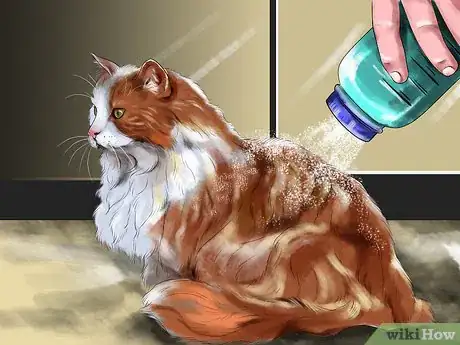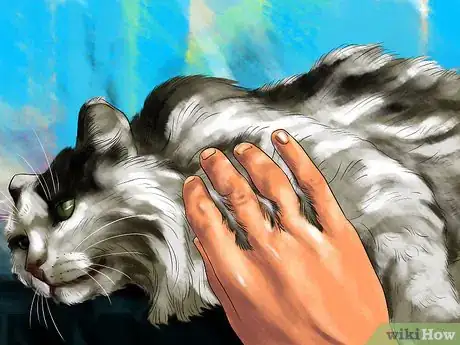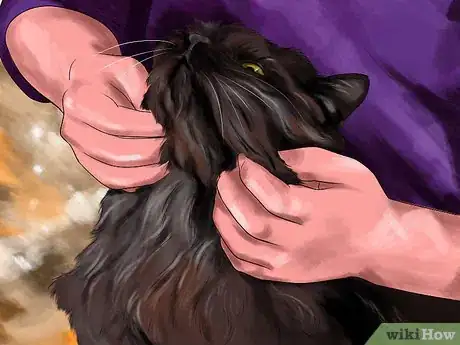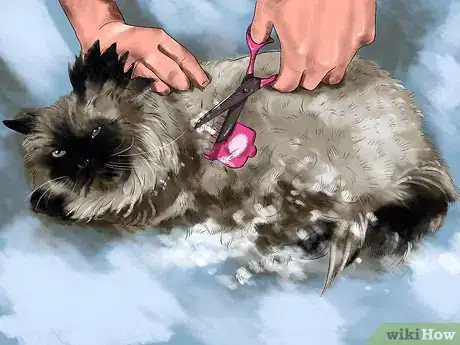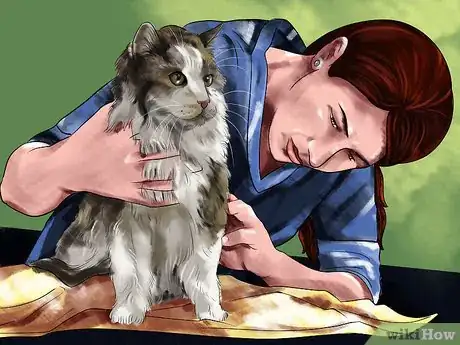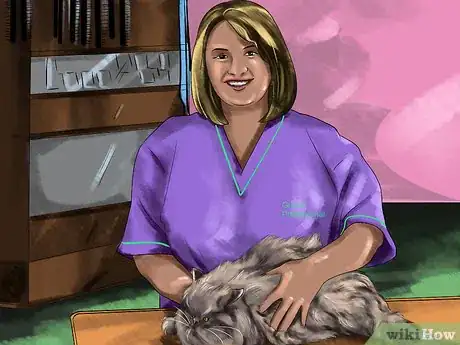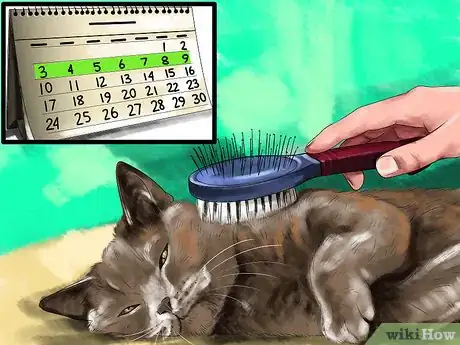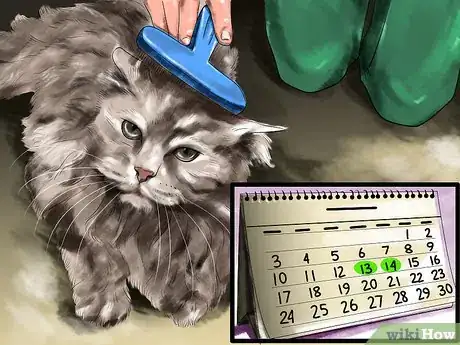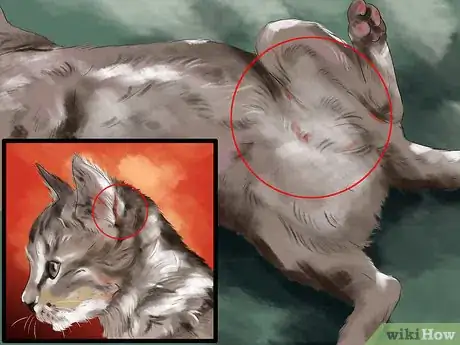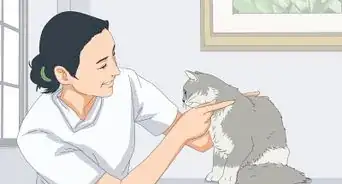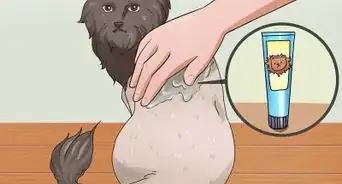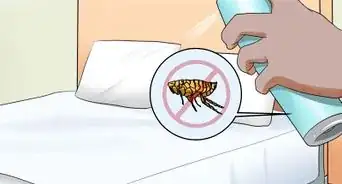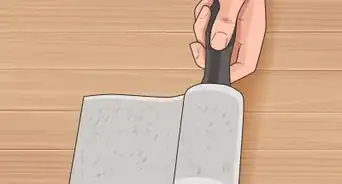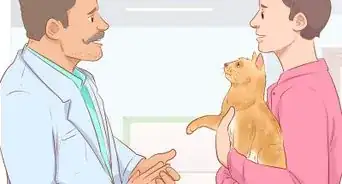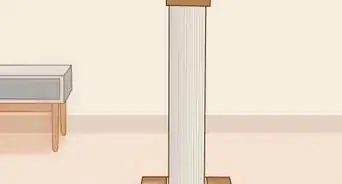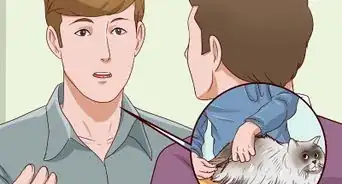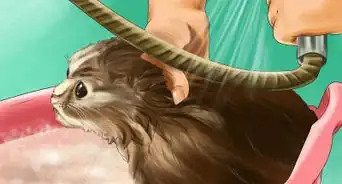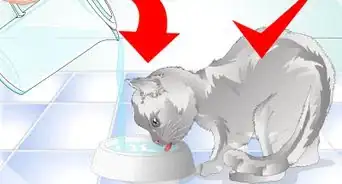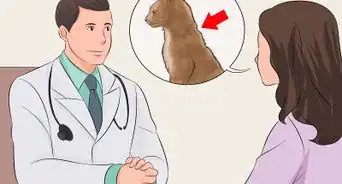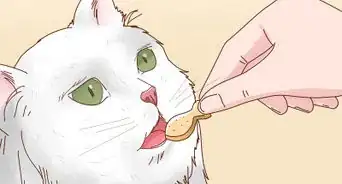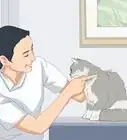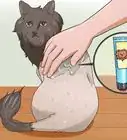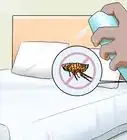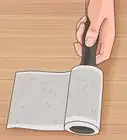This article was co-authored by Melissa Nelson, DVM, PhD. Dr. Nelson is a Veterinarian who specializes in Companion and Large Animal Medicine in Minnesota, where she has over 18 years of experience as a veterinarian in a rural clinic. She received her Doctor of Veterinary Medicine from the University of Minnesota in 1998.
This article has been viewed 20,485 times.
You can handle small mats in your cat's fur at home by using talcum powder, your fingers, and a wide-toothed comb to loosen and remove them. However, if you are dealing with a stubborn mat, you may use scissors with caution to remove it. If the mat is large, close to your cat’s skin, or very stubborn, then you may need a professional to remove it safely. Prevent mats by brushing your cat regularly, especially the areas where mats commonly occur.
Steps
Combing Out Small Mats
-
1Sprinkle talcum powder onto the mat. Work the talcum powder into the mat with your fingers. The talcum powder will help loosen the mat. You can purchase talcum powder from your local pharmacy or grocery store.[1]
- Alternatively, you can spray a detangler or an anti-static spray onto the mat to loosen it, though do not use both at once or the products can cake together and make the problem worse. You can find these at your local pet store or online.
-
2Use your fingers to loosen the mat. Gently pull any loose hair away from the mat with your fingers. Break the mat apart as much as you can without using a comb. Do this until only the core of the mat remains.[2]Advertisement
-
3Hold the base of your cat’s hair with your fingers. Starting at the end of the mat, i.e., the tip of your cat’s hair, begin to gently comb the mat. Use a wide-toothed metal comb or a specially-made mat comb (also called a razor comb or mat rake) to work through it. As it breaks apart, slowly work your way deeper into your cat’s fur until the whole mat is removed.[3]
- Use short, fast strokes to remove the mat. Do not yank or pull too hard.
- If you are using a wide-toothed comb, use the tip of the comb as a pick to work your way through the mat.
- If your cat has a double coat or a thick undercoat, then use an undercoat comb to work through the mat. Finish this in multiple sessions if your cat does not tolerate it well.
Removing Mats with Scissors
-
1Lift the hair from the skin. Use a comb to do this. By lifting the hair away from the skin, it will be easier to see where the fur stops and the skin begins. This way, you may reduce the risk of accidentally cutting or nipping your cat’s skin.[4]
-
2Cut the edges of the mat. While the hair is lifted with the comb, take a pair of scissors and cut the edges of the mat. To be safe, only cut the edges of the mat on the outside of the comb, i.e., the part of the mat that is farthest from your cat’s skin. Cutting the edges of the mat will loosen the mat, making it easier to detangle with your fingers or a comb.[5]
- Never lie the scissors flat onto your cat’s fur and skin. By doing this, you may risk cutting your cat’s skin. Always use a comb to lift the mat away from your cat’s skin before cutting the edges of the mat.
-
3Use your fingers to detangle the rest of the mat. You can also use a wide-toothed comb or a mat comb to untangle the rest of the mat. If the mat will not come loose, then use the comb and scissors again to cut the edges of the mat. Resume untangling the mat with your fingers or a comb.[6]
-
4Take your cat to a professional groomer. In general, mats that are smaller than the tip of your thumb can be easily removed at home without professional help. However, if the mat is very large, tight, or close to your cat’s skin, then you may want to take your cat to a professional groomer to have it removed.[7]
- Additionally, if your cat’s coat is covered in mats, then you should take it to a professional groomer or your veterinarian to have them removed. In severe cases, the professional may need to shave your cat.
- Sedation may be necessary for the shaving process since removing the mats can be very painful.
Preventing Mats
-
1Brush shorthaired cats once a week. Use a metal or rubber fine-toothed comb to remove dead hair, dirt, and oil from a shorthaired cat's coat. When brushing your cat, remember to brush in the direction of its hair growth. Also make sure to brush your cat’s whole body, from head to tail, including its abdomen and chest.[8]
-
2Brush longhaired cats every two days. Use long-toothed slicker brushes and combs to brush longhaired cats. Starting with your cat’s abdomen and legs, gently comb its fur upward toward its head. Also comb your cat’s neck fur upward toward its chin. However, comb the hair on the top side of the coat in the direction of the hair growth.[9]
- In order to brush the tail, part the hair down the middle and carefully brush out the fur on both sides.
-
3Check for mats in common areas. When combing your cat, make sure to check areas where mats commonly occur. These areas are around the groin and abdomen, behind the ears, between the back legs, behind the front legs (its armpits), around the collar area, and along the back of the haunches.[10]
Warnings
- Do not use water to break up mats. Water will only make the mats harder to remove.⧼thumbs_response⧽
References
- ↑ http://www.aspca.org/pet-care/cat-care/cat-grooming-tips
- ↑ http://www.petco.com/content/petco/PetcoStore/en_US/pet-services/resource-center/grooming/Combing-Out-a-Mat-from-Your-Cat-Hair-or-Fur.html
- ↑ http://www.petful.com/grooming/how-remove-mats-long-haired-cat/
- ↑ http://www.petful.com/grooming/how-remove-mats-long-haired-cat/
- ↑ http://www.petful.com/grooming/how-remove-mats-long-haired-cat/
- ↑ http://www.petful.com/grooming/how-remove-mats-long-haired-cat/
- ↑ http://www.petco.com/content/petco/PetcoStore/en_US/pet-services/resource-center/grooming/Combing-Out-a-Mat-from-Your-Cat-Hair-or-Fur.html
- ↑ http://www.aspca.org/pet-care/cat-care/cat-grooming-tips
- ↑ http://www.aspca.org/pet-care/cat-care/cat-grooming-tips
About This Article
To handle matting in your cat’s coat, start by working some talcum powder or detangler into the mat with your fingers to loosen it. Continue using your fingers to gently pull any loose hair away from the mat until only the core remains. You can then gently comb the mat while holding the base of your cat’s hair with your fingers to avoid hurting it. For larger or more difficult mats, use a comb to lift the matted hair away from the skin. While the hair is lifted, use scissors to cut the edges of the mat, which will loosen it. Once you’ve cut away part of the mat, use your fingers to detangle the rest of it. For more tips from our Veterinary co-author, including how to prevent mats, keep reading!
